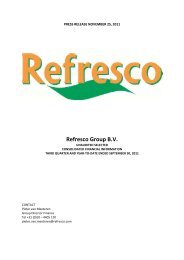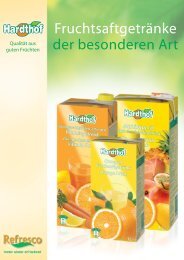You also want an ePaper? Increase the reach of your titles
YUMPU automatically turns print PDFs into web optimized ePapers that Google loves.
for retailers <strong>de</strong>veloping private label because<br />
trading up consumers” Koen <strong>de</strong> Jong, IPLC<br />
In what product category does private label have the highest share?<br />
Grievink: “Private label serves several purposes, which makes<br />
its influence so broad throughout all categories and segments.<br />
But looking at single categories, private label has the highest<br />
share in fresh.” De Jong adds: “Fresh is particularly the<br />
domain of the retailers. They are by far in the best position<br />
to organize and optimize the logistical process and make it<br />
highly profitable. The fresh market is too complex for A-brands<br />
because of the logistics. Next to fresh you also find a high<br />
share of private label in commodity products.” Schreijen<br />
comments: “Categories where you can find high shares of<br />
private label are frequently in products with no emotional value<br />
e.g. in paper (tissue, toilet paper etc.). Categories such as beer,<br />
on the contrary, are hard to enter with private label because<br />
of the emotional value attached to beer.” “And,” adds De Jong,<br />
“another category where private label market share is relatively<br />
low is personal care, like shampoo, <strong>de</strong>odorants, and skin care.<br />
Consumers trust the brands they have been using for years and<br />
brand loyalty is very high in this category, partly due to the<br />
heavy promotional support of the brand owners. Apparently<br />
people are sensitive about personal care products and it seems<br />
tough to convince them to try alternatives. Moreover, the<br />
category chocolate candy bars is dominated by A-brands. The<br />
brands are offered in every store, gas station etc., so retailers<br />
are obliged to offer this to their customers as well, and in<br />
addition it seems difficult to produce a shelf-perishable product<br />
for retailers.”<br />
What are the <strong>de</strong>velopments of private label<br />
in the beverages category?<br />
De Jong: “The share of private label in the non-alcoholic<br />
beverages category has been growing fast, which has led to<br />
the disappearance of many B- and C-brands. Looking at the<br />
brand share in non-alcoholic beverages, there is a difference<br />
in non-carbonated soft drinks, like juices and carbonated<br />
soft drinks, like cola. Whereas in non-carbonated soft drinks<br />
there is a high share of local A-brand heroes, in carbonated<br />
soft drinks you see more of the international A-brands. Both<br />
show high brand loyalty. In non-carbonated soft drinks,<br />
retailers are <strong>de</strong>veloping varieties in flavors un<strong>de</strong>r private label<br />
though, which do not yet exist un<strong>de</strong>r A-brands. They have an<br />
advantage here, because it is easy for retailers to vary and<br />
it keeps their shelves vivid. This is a less attractive area for<br />
A-brands because their first goal is to build consumer loyalty<br />
to the product. They will not <strong>de</strong>velop temporary flavors which<br />
have to be removed from the shelf after a short period.”<br />
Where do you see the most striking growth in private label?<br />
Grievink: “Generally speaking, I expect that the total private<br />
label category in Europe will grow in the next few years, not so<br />
much in autonomous growth, but because of the introduction<br />
of new varieties. The front-running countries, the UK and<br />
Switzerland, will show stabilization in growth in private label<br />
share now it has reached about a 50% market share (volume)<br />
in both countries. The biggest growth of private label can<br />
be distinguished in fresh and frozen. These are now already<br />
categories where private label is almost overly represented.<br />
The focus will be even more on convenience, portion packs,<br />
and fresh-cut fruit or vegetables. Along with the growth of<br />
private label products, this category also offers opportunities<br />
for A-brands to enter. Looking at long-term growth over<br />
ten years in the different private label types, I expect the<br />
largest growth in the fourth type: hard discount. Value for<br />
money becomes increasingly more important, and consumers<br />
are becoming smarter. An already visible trend is the hard<br />
discounters transforming into primary supermarkets where<br />
people do their daily or regular shopping.” De Jong refutes this:<br />
“I do not believe that hard discounters will be able to replace<br />
primary supermarkets because their service level is not as high<br />
as that of retailers. Their portfolio is simply too narrow and<br />
shallow. Consumers want choice, and that’s what is lacking in<br />
hard discount. For every product they offer only one variety,<br />
while at retailers’ stores consumers can choose between<br />
several brands, private label and value labels.” Schreijen: “Due<br />
to brand promotions, hard discount is currently growing less<br />
vigorously than end-2008.”<br />
De Jong: “Another type, value (like Carrefour Discount, Tesco<br />
Value or Delhaize 365), is currently growing very strongly, but<br />
since this type is not very profitable for retailers I don’t expect<br />
huge future growth here.”<br />
page _ 48 / 49







